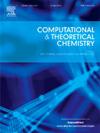Atomic-scale research of the formation mechanism of passivation films on Al (111) surface
IF 3
3区 化学
Q3 CHEMISTRY, PHYSICAL
引用次数: 0
Abstract
The adsorption and diffusion processes of oxygen atoms on the Al (111) surface were investigated using first-principles computational methods. The most stable adsorption site for oxygen atoms on the Al (111) surface was identified as the Fcc site. Upon oxygen adsorption, the Al (111) surface undergoes passivation. Aluminum and oxygen atoms form bonds through the hybridization of O-2p and Al-3p orbitals, with the Al-O bond exhibiting ionic characteristics. The adsorption energy of oxygen atoms on the Al(111) surface is significantly higher than that of chlorine atoms, indicating that oxygen atoms have a higher adsorption priority and are more likely to adsorb and accumulate on the surface. Increasing aluminum vacancies and enhancing oxygen coverage effectively reduce the energy barrier for oxygen atom diffusion into the subsurface, facilitating their inward migration. Molecular oxygen spontaneously dissociates into oxygen atoms upon surface adsorption, and the adsorption and diffusion of oxygen atoms are thermodynamically favorable. Chlorine atoms promote the formation of the passivation film by lowering the vacancy formation energy and the diffusion energy barrier for oxygen atoms, enabling the rapid development of the passivation layer. These findings elucidate the formation process and mechanism of passivation films on aluminum alloy surfaces, clarify the role of chloride ions, and provide theoretical insights and references for studies on the corrosion resistance of aluminum alloys.

求助全文
约1分钟内获得全文
求助全文
来源期刊

Computational and Theoretical Chemistry
CHEMISTRY, PHYSICAL-
CiteScore
4.20
自引率
10.70%
发文量
331
审稿时长
31 days
期刊介绍:
Computational and Theoretical Chemistry publishes high quality, original reports of significance in computational and theoretical chemistry including those that deal with problems of structure, properties, energetics, weak interactions, reaction mechanisms, catalysis, and reaction rates involving atoms, molecules, clusters, surfaces, and bulk matter.
 求助内容:
求助内容: 应助结果提醒方式:
应助结果提醒方式:


